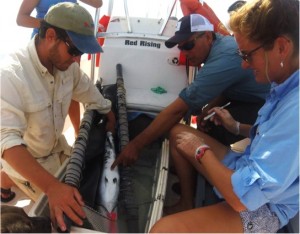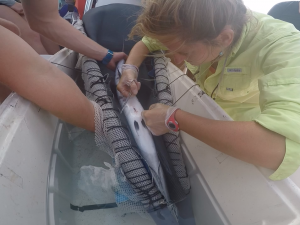In February, the research team led by Dr. Aaron Shultz and Georgiana Burruss (CEI) successfully implanted the last bonefish with an acoustic transmitter, bringing the sample size to 39 bonefish that they will track over the next three years! The data collected from these fish will provide insight into the locations of movement corridors and prespawning aggregations, as well as potential cues for bonefish spawning (e.g., moon cycle, tidal cycle, weather patterns, etc.). These locations can then be used to designate marine protected area that will aid in the conservation of this ecologically and economically important species.

A second study was recently launched to evaluate if bonefish prespawning aggregations attract predators. Anecdotally, coastal predators such as sharks and Great Barracuda have been observed preying on spawning aggregations of bonefish. Unfortunately, these associations between predators and spawning aggregations are not well-studied, resulting in a knowledge gap regarding how bonefish aggregations could dictate the abundance of apex predators in localized areas. Using a known bonefish prespawning aggregation as a model, this study aims to determine if bonefish aggregations attract predators and if these predators are returning to the aggregation site repeatedly. Barracuda are a known predator of bonefish in shallow flats and they are common near the location of the bonefish prespawning aggregation, making them an ideal species to study predator movement patterns in relation to bonefish aggregation.
With the assistance of Zach Zuckerman, barracuda were captured using SpiderWire and Dyneema fishing line at locations near and far-away from the bonefish prespawning aggregation. VEMCO acoustic transmitters were surgically implanted into 14 barracuda. These fish will be tracked passively, utilizing the receiver array placed around the island, as well as actively, when researchers are tracking bonefish aggregations overnight. Surprisingly, one barracuda closely followed a bonefish spawning aggregation for over 6 hours!

This study will continue to track bonefish and predator movements around Eleuthera over the next three years. For more information about our research and how to support, please contact georgianaburruss@islandschool.org and aaron.dean.shultz@gmail.com. Keep an eye out for more updates!